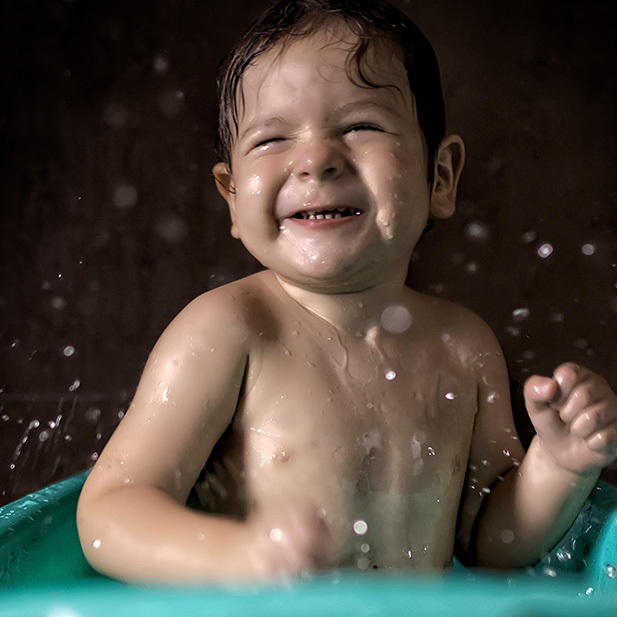
Healthy baby skin – how to protect your child’s sensitive skin.
Soft, elastic, and resistant: the skin is our largest organ and fulfils numerous vital functions. The skin of babies and toddlers is much more sensitive and permeable than adult skin and therefore needs special care. In the following blog, you will learn how baby and children’s skin differs from adults and how you can take good care of it.
What is the difference between baby skin and adult skin?
Your baby’s skin is much thinner than your own. In addition, the uppermost cell layer and the horny layer have a looser structure and are therefore less resistant to pathogens and pollutants. That is why baby’s skin reacts more sensitively to environmental influences. From birth and in the early stages of life, the pH value of the baby’s skin is neutral. The natural acid mantle, which is an additional protective function, forms after a few weeks and regenerates much more slowly in older children than in you. Since the top layer of baby’s skin contains more water, but at the same time is only covered with a very thin film of water and fat, it can dry out more easily and is more susceptible to irritation and cracks in the cold or after injuries. All in all, this means that your baby is less protected against external influences. Studies have shown that the development process of the skin protection barrier can last at least until the end of the fourth year of life. That is why it is especially important to pay attention to the substances your child comes into contact with, for example through skin care products, fabric detergents, room fragrances and the environment.
What disturbs the skin protection barrier of infants?
- Water: Frequent and long bathing, i.e. intensive contact with water, can lead to the fats being washed out of the protective horny layer of the skin. The skin swells and dries out.
- Climate: Dry air, wind and heat also have a drying effect.
- Friction: The uppermost cell layer of the baby’s skin is still very thin. Strong rubbing when cleaning the nappy area should therefore be avoided.
- Irritants: Unsuitable care and cleansing products have a negative effect on both the skin’s moisturising lipid film and its pH value.
- UV radiation: Your baby’s skin contains little UV-protective melanin and pigment-forming cells, especially in the first year of life. That’s why you should protect your baby from the sun with the right clothes.
- Too little air on the skin: In the enclosed area of the nappy – for example, if it is changed too seldom – there can be an increased moisture content. With the effect: water-soluble substances can penetrate the skin more easily and cause irritation.

How to protect your baby’s sensitive skin.
- You don’t need to bathe your baby every day, once or twice a week is ok in the first few weeks. You may prefer to wash their face, neck, hands, and bottom instead. This is often called “topping and tailing”.
- Your baby’s bath water should be between 36°-37°C and baths should be quick and fun. Washing for too long can reduce skin’s natural oils, increasing the risk of irritation. After the bath pat the skin dry rather than rubbing as rough drying can aggravate sensitive skin.
- Don’t add any bubble bath to the water. Plain water is best for your baby’s skin in the first month.
- Sensitive, skin-friendly nappies. Nappies are so important when you become a parent. Firstly, because your baby uses so many through their lifetime, and secondly because you obsess over the contents, don’t worry, we all do it! There are two main types of nappies out there, disposable nappies and reusable cloth nappies. Some parents choose to use only disposable nappies, some only reusable, and some a mix of both.
Disposable nappies. Sensitive babies can have an allergic reaction to irritating chemicals that may be present in some disposable nappies. These chemicals include parabens (a type of cosmetic preservative) and dioxins (used to bleach and whiten the nappies’ material). There are disposable nappies available on the market which contain premium cotton and soft plant-based fibres which are gentle on your baby’s skin. They contain 0% perfume, lotion and free of allergens.
Cloth nappies for sensitive skin help prevent two kinds of irritation; allergic reactions to chemicals found in some disposable nappies and nappy rash caused by the skin’s prolonged exposure to moisture.
- For the infamous nappy accidents, clean your baby’s bottom with water and a special baby cleansing gel (soap-free, without fragrances, parabens and microplastics) or with a cotton pad soaked in no-rinse cleansing fluid. You can also use wipes, once your baby’s skin is more mature. Avoid soaps and perfumed baby wipes as these can irritate the skin. Use soft towels or cotton wool when drying the skin and dab the area gently.
The UK NHS advice is “Take off the nappy and wash your baby’s bottom and genital area with fresh cotton wool and warm water” – no cleansers until older.
- Nappy cream. Sitting in a nappy can cause irritation on your little one’s bottom, no matter how often you change them. First of all, don’t panic, this is an extremely common problem. Normally when we experience irritation from friction, we’d reach for a talcum powder. However, according to the NHS, you shouldn’t use talcum powder as it contains ingredients that could irritate your baby’s skin. Enter: nappy cream, an ointment that acts as a barrier to block your baby’s delicate skin from the nappy and its contents. If you can already see some irritation forming, nappy barrier cream will help to protect their soft skin from dampness and friction that might cause more damage.
- Sun protection: Babies less than 6 months old should be kept out of direct sunlight. Their skin contains too little melanin, which is the pigment that gives skin, hair, and eyes their colour, and provides some protection from the sun. In summer, it is best to go out with your children in the morning or evening when the sun is not so strong. For babies over 6 months, apply a sunscreen with a sun protection factor (SPF) of at least 30-50 to your baby’s skin. Make sure the product also protects against both UVA and UVB rays. Many brands produce sunscreen specifically for babies and young children, as these products are less likely to contain additives that might irritate the skin. Apply the sun cream regularly, particularly if your child is in and out of the sea or paddling pool. Make sure your child wears a sunhat with a wide brim or a long flap at the back to protect their head and neck from the sun. A parasol (like an umbrella, but with UV protection) also provides cooling shade to protect your child’s sensitive skin.
- Be careful of household products. The ingredients of cleaning products can be absorbed through the lungs and also through the sensitive baby skin. Therefore, do not only pay attention to what you apply directly to your baby, but also to what substances you expose them to in everyday life. Cleaning products without phosphates, bleaching agents, solvents, preservatives, and fragrances are ideal. All-purpose cleaners containing ammonia can cause respiratory irritations, especially to vulnerable family members – children and elderly. These and other toxic ingredients are the reason you should take it easy with the use of such products at home, especially if you have baby or toddler. Avoid cleaning products labelled “irritant” or “corrosive” – this already applies during pregnancy. This is because the toxins you ingest could reach your baby through the placenta or breast/chest milk.
- Wash new textiles. When you buy new clothes, toys, breast/chestfeeding pillows, bedding etc for your baby, it’s best to wash them before your baby wears them or comes into contact with them for the first time. This will help to remove any substances or dust that may irritate your baby’s delicate skin. Some parents prefer to use non-biological detergent to wash their baby’s clothes. Biological detergents contain enzymes that help to remove stains, but some parents worry that these enzymes will irritate their baby’s skin. There isn’t much evidence for this, but you may want to play it safe. If your baby has very sensitive skin, it is probably best to switch to a baby-specific detergent. These are specially formulated for your baby’s skin. When buying baby clothes or textiles for your living room, it is best to look for natural, tested materials (cotton, linen, viscose) and the “Oeko-Tex 100” label. It identifies products that are free and low in harmful substances.
- The right detergent. You can wash your baby’s clothes at 30 degrees C to help you to save you money. If you aren’t using a different detergent for your baby’s clothes, you can wash your baby’s clothes as part of a full load of laundry. They will still get clean, and it will also mean that you can put on fewer loads.
Preservatives such as methylisothiazolinone (and similar) in cleaning products, hair care products and detergents can cause contact allergies. Baby skin is so thin and permeable that fragrances and fabric softeners also penetrate easily.
We hope this blog has provided some key tips to protect your baby’s skin right from the start. And in general, when it comes to products: the more natural the better.
_________________________________________________________________________________



